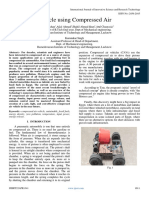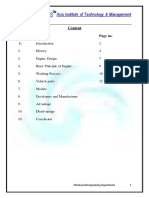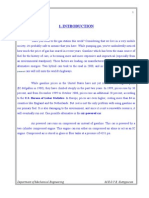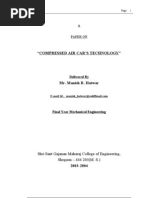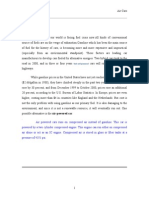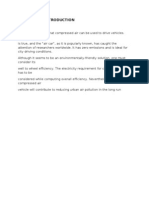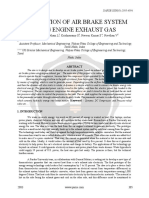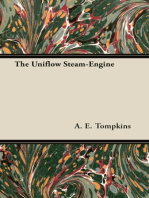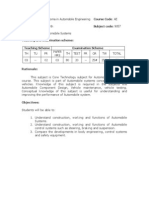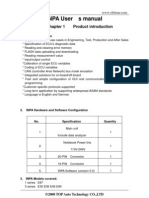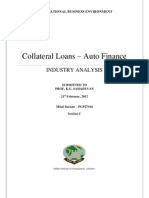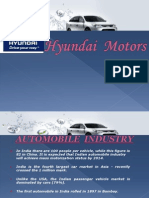Art 20172846
Art 20172846
Uploaded by
Miskoncha MiskonchaCopyright:
Available Formats
Art 20172846
Art 20172846
Uploaded by
Miskoncha MiskonchaCopyright
Available Formats
Share this document
Did you find this document useful?
Is this content inappropriate?
Copyright:
Available Formats
Art 20172846
Art 20172846
Uploaded by
Miskoncha MiskonchaCopyright:
Available Formats
International Journal of Science and Research (IJSR)
ISSN (Online): 2319-7064
Index Copernicus Value (2015): 78.96 | Impact Factor (2015): 6.391
Air Powered Car - Future of Transportation
Ashish Jiotode1, Pravin Jeurkar2, Abhijit Wadhai3
1
Amravati University, Babasaheb Naik College of Engineering, Pusad, Maharashtra, India
2
Amravati University, Babasaheb Naik College of Engineering, Pusad, Maharashtra, India
3
Amravati University, Babasaheb Naik College of Engineering, Pusad, Maharashtra, India
Abstract: Transportation is the most vital part in our day to day life. If it won’t be there life would not be this easy. Transportation
consist of cars, trucks, trains, etc. which requires petrol and diesel as a fuel to run. As we all know that fuel is non-renewable sources of
energy and also the prices of fuel increases day by day. So under the vision of this concept we introduce some new ideas in this paper.
Here we used AIR as a fuel to run the automobiles. As air is free to us and renewable source of energy and most reliable too. In this we
used Air for intake and also we used carbon filter for removing the dust particles. For this we don’t need petrol or diesel, we can directly
run engine by air. This will be very helpful to people. Also it will be most useful for industries. Cost rate of transportation will be less. In
future it will be more advantageous and useful. TATA MOTORS make an agreement with Motor Development International MDI of
France to develop a car that runs on compressed air. Also it will be more economical and pollution free. The cost of refilling the air will
be very less as compared to petrol or diesel.
Keywords: Air Engine, Compressed tank, Compressed Air fuel
1. Introduction Approximately 90m3 of compressed air is stored in fiber
tank in the vehicle.
We know that our world is facing fuel crisis now. All kinds The engine is powered by compressed air, stored in a
of conventional source of fuel for the history of cars carbon-fiber tank at 30Mpa (4500psi). The tank is made of
becoming more and more expensive and impractical carbon fiber in order to reduce its weight.
especially from an environment. These factors are leading car The engine has injection similar to normal engines, but
manufacture to develop car fuel-cell-powered cars will roll uses special crankshafts and pistons, which remain at top
onto the world’s highway. dead center for about 70 degrees of the crankshaft’s cycles;
this allows more power to be developed in the engine.
Compressed air as a source of energy in different uses in Also we can use Turbocharger for increasing the speed.
general and as a nonpolluting fuel in compressed air vehicles The expansion of this air pushes the piston and creates
has attracted scientists and engineers for centuries. Efforts are movement. The atmospheric temperature is used to re-heat
being made by many developers and manufacturers to master the engine and increase the road coverage
the compressed air vehicle technology in all respects for its The air conditioning system makes use of expelled cold air.
earliest use by the mankind. The present paper gives a brief
introduction to the latest developments of a compressed-air 3. How Compressed Air Can Fuel a Car
vehicle along with an introduction to various problems
associated with the technology and their solution. While
developing of compressed air vehicle, control of compressed
air parameters like temperature, energy density, requirement
of input power, energy release and emission control have to
be mastered for the development of a safe, light and cost
effective compressed air vehicle in near future.
2. How Does Air Engine Work
Figure 2: The Chassis
In practical terms compressed air at 300 bars is stored in the
carbon fiber tank A. Air is release through the main line
firstly to an alternator B where the first stage of
decompression takes place. The now cold air passes through
heat exchanger C which adds thermal energy to the air and
provides a convenient opportunity for air conditioning D.
The warm compressed air now passes to the motor E where
two more stages of decompression and reheating takes place.
Figure 1: Air Engine The motor drives the real axle G through the transmission F.
Volume 6 Issue 4, April 2017
www.ijsr.net
Licensed Under Creative Commons Attribution CC BY
Paper ID: ART20172846 2125
International Journal of Science and Research (IJSR)
ISSN (Online): 2319-7064
Index Copernicus Value (2015): 78.96 | Impact Factor (2015): 6.391
Control of engine speed is through conventional accelerator air that comes out of the car is cleaner than the air that
pedal H controlling a valve within the motor. went in.
4. Compressed Air Tanks 6. Technology Description
The following is the description of the actual functionality of
the motor.
Figure 3: compressed tank
Compressed air tanks are one of the major part of this car. Figure 4: Structure of Air Engine
This tank holds 90 cubic meters of air compressed to 300
bars. It is similar to the tanks used to carry the liquid gas used 7. Process Description
by buses for public transport. The tanks enjoy the same
technology developed to contain natural gas. They are 1. The first piston takes in ambient air and compresses it to
designed and officially approved to carry an explosive approximately 300 psi and 200 *F in the compression
product: methane gas. chamber during the first cycle of the engine.
In case of major accident, where the tanks are ruptured, they 2. When the piston pause, a small amount of compressed air
would not explode since they are not metal. Instead they from the tanks is released into the expansion chamber to
would crack, as they are made of carbon fiber. An elongated create a low pressure, low temperature volume of about
crack would appear in the tank, without exploding, and the 140psi.
air would simply escape, producing a loud but harmless 3. Shortly before the valve to the exhaust cylinder is opened,
noise. Of course, since this technology is licensed to transport a high speed shutter connects the compression and
an inflammable and explosive gas (Natural gas), it is expansion chambers.
perfectly capable inoffensive and non-flammable air. 4. The sudden pressure and temperature difference between
the low chambers creates pressure waves in the expansion
It is fitting, that MDI has reached an agreement with the chamber, thereby producing work in the exhaust chamber
European Leader in aerospace technology air bus industries that drives the piston to power the engine.
for the manufacture of the compressed air storage tanks. With 5. The air tanks for storing the compressed air are localized
a remote supervision arrangement, Air bus industries underneath the vehicle. They are constructed of reinforced
overseas the making of the storage tanks at each MDI carbon fiber with a thermoplastic liner. Each tank can hold
factory. The coiled carbon fiber technology used in the 3,180 ft3 of air at a pressure of up to 4,300 psi. When
construction of the tanks is complex and requires a connected to a special compressor station, the tanks can be
substantial quality control process which the multinational recharged within 3-4 min. They can also be recharged
company, home of the Airbus aircraft, will provide for our using the onboard compressor 3-4 hours after connecting to
vehicles. a standard power outlet.
5. The Air Filter 8. Working
The engines work with both air taken from atmosphere and
air pre-compressed in tanks. Air is compressed by the on-
board compressor or at service station equipped with a high
pressure compressor.
Before compression, the air must be filtered to get rid of
any impurities that could damage the engine. Carbon filters
are used to eliminate dirt, dust, humidity and other particles
which unfortunately are found in the air in our cities.
This represents a true revolution in automobiles – it is the
first time that a car has produced minus pollution, i.e. it
eliminates and reduces exciting pollution rather than
emitting dirt and harmful gases. The exhaust pipe on the
car produces clean air which is cold on exit (between -15o
and 0o) and is harmless to human life. With this system the
Figure 4: Compressed Air Engine
Volume 6 Issue 4, April 2017
www.ijsr.net
Licensed Under Creative Commons Attribution CC BY
Paper ID: ART20172846 2126
International Journal of Science and Research (IJSR)
ISSN (Online): 2319-7064
Index Copernicus Value (2015): 78.96 | Impact Factor (2015): 6.391
9. How Air Car Helps to Reduce Pollution it would either take a long time to fill the tank, or they
would have to take less than a full charge(since heat drives
The most important pollutants in car exhaust include: up the pressure).
Carbon monoxide (a piston) is formed because combustion 12. A Car That Run On Air, In India Soon
is incomplete. Not enough oxygen is available fast enough
to react with all of the carbon available. TATA MOTORS has signed an agreement with MOTOR
Nitrogen oxides – Because of the pressure and temperature DEVELOPMENT INTERNATIONAL of FRANCE to
inside a cylinder, nitrogen and oxygen in the air combine in develop a car that runs on compressed air, thus making it
various ways. very economical to run and be almost totally pollution free.
Unburned hydrocarbons – not all of the hydrocarbons Although there is no official word on when the car will be
participate in the reaction because there is so little time commercially manufactured for INDIA, reports say that it
available during the combustion phase. will be sooner.
As about gasoline is the main source of pollution, if we The car could cost around Rs 350,000 in INDIA and
used compressed air instead of gasoline then we can would have a range of around 300 km between refuels.
improve environment. The cost of a refill would be about Rs 90.
As we know that nitrogen is the main constituent of
environment, in case of air car we extract nitrogen from 13. Conclusion
environment, liquefy it and used as fuel in car, then there
will be nitrogen, only the exhaust gas which is not harmful For the entire disruption made one can say that by using air
to human being and environment. By using liquid nitrogen car there is reduction in air pollution. The emission benefits
(compressed) in car, we can reduce pollution up to 70- of introducing this zero emission technology are obvious.
80%. Also the aim of project is to cut cost, create job locally. Also
air car provides an answer to the shortage of fuel and high
10. Advantages of Air Car price of fuel.
Refueling can be done at home using an air compressor or With petrol and diesel prices going up and the price of oil
at service station. The energy required for compressing air subjects to fluctuation for motorist, this will be shortage
is produced at large centralized plants, making it less costly gasoline (petrol, diesel), in future, engine that runs on
and more effective to manage carbon emission than from compressed air is only the alternative for it.
individual vehicles.
Compressed air engine reduce the cost of vehicle Reference
production by about 20%, because there is no need to build
a cooling system, spark plugs, starter motor, or muffler. [1] www.theaircar.com
The rate of self-discharge is low opposed to batteries that [2] www.google.com
depilate their charge slowly over time. Therefore the [3] www.howstuffworks.com
vehicle maybe left unused for longer periods of time than [4] www.zeropollution.com
electric cars. [5] IC Engine Book of “V Ganesan”
Compressed-air vehicles emit few pollutants, mostly dust [6] Mathur Sharma “IC Engine” Dhanpat Rai Publication
from brake and tire wear. Refueling can be done at home (1999)
using an air compressor or at service station. The energy
required for compressing air is produced at large
centralized plants, making it less costly and more effective
to manage carbon emission than from individual vehicles.
Compressed air engine reduce the cost of vehicle
production by about 20%, because there is no need to build
a cooling system, spark plugs, starter motor, or muffler.
The rate of self-discharge is low opposed to batteries that
depilate their charge slowly over time. Therefore the
vehicle maybe left unused for longer periods of time than
electric cars.
Compressed-air vehicles
Lighter vehicles would result in less wear on roads.
11. Disadvantages of Air Car
Refueling the compressed air container using a home or
low-end conventional air compressor may take as long as 4
hours tough the specialized equipment at service station
may fill the tanks only in 3 min.
Tanks get warm when they filled rapidly. It would be
difficult to cool the tank efficiently while charging and thus
Volume 6 Issue 4, April 2017
www.ijsr.net
Licensed Under Creative Commons Attribution CC BY
Paper ID: ART20172846 2127
You might also like
- Supply Chain in Tyre Industry 2017Document11 pagesSupply Chain in Tyre Industry 2017Payal Priya Chand75% (4)
- Vehicle Using Compressed AirDocument5 pagesVehicle Using Compressed AirDHANUSH RAJ LNo ratings yet
- Vehicle Using Compressed AirDocument5 pagesVehicle Using Compressed AirInternational Journal of Innovative Science and Research TechnologyNo ratings yet
- Pneumatic Powered Air EngineDocument4 pagesPneumatic Powered Air EngineRegg ParkerNo ratings yet
- IOSRDocument7 pagesIOSRrobsonrober83No ratings yet
- IOSRDocument6 pagesIOSRmuner886644No ratings yet
- Guide By-Submitted by - Mr. Gaurav Upadhayay Saurabh Singh (Assistant Professor) M.E-3BDocument20 pagesGuide By-Submitted by - Mr. Gaurav Upadhayay Saurabh Singh (Assistant Professor) M.E-3BBilal AnsariNo ratings yet
- Air Powered EngineDocument6 pagesAir Powered Engineolangocollins12No ratings yet
- Design Methodology For Compressed Air EngineDocument7 pagesDesign Methodology For Compressed Air EngineShashank SrivastavaNo ratings yet
- Air Car: - Light Utility Vehicles Are Becoming Very Popular Means of Independent TransportationDocument8 pagesAir Car: - Light Utility Vehicles Are Becoming Very Popular Means of Independent TransportationNabeel KhanNo ratings yet
- Submitted By: "Compressed Air Engine Technology"Document11 pagesSubmitted By: "Compressed Air Engine Technology"harshmehla009No ratings yet
- Compressed Air EngineDocument19 pagesCompressed Air EngineDevendra Pratap SinghNo ratings yet
- Design & Fabrication of Pneumatic Air Engine: International Research Journal of Engineering and Technology (IRJET)Document4 pagesDesign & Fabrication of Pneumatic Air Engine: International Research Journal of Engineering and Technology (IRJET)ChandramanikandanNo ratings yet
- Irjet V7i5157Document3 pagesIrjet V7i5157ankNo ratings yet
- Axis Institute of Technology & Management: S.No. Page No. 1Document32 pagesAxis Institute of Technology & Management: S.No. Page No. 1VishnuNo ratings yet
- Air Driven EngineDocument19 pagesAir Driven EngineVivek PatilNo ratings yet
- Venkat Seminar PDFDocument13 pagesVenkat Seminar PDFjagannathnaidu752No ratings yet
- Air Car - The Future of TransportationDocument20 pagesAir Car - The Future of TransportationyogeeshNo ratings yet
- Journal of Refrigeration, Air Conditioning, Heating and Ventilation Design of A Compressed Air VehicleDocument7 pagesJournal of Refrigeration, Air Conditioning, Heating and Ventilation Design of A Compressed Air VehicleThoni LacknerNo ratings yet
- Compressed Air Engines SynopsisDocument6 pagesCompressed Air Engines Synopsisalfambar902100% (1)
- Air CarsDocument24 pagesAir CarsN C AbhijithNo ratings yet
- Study and Fabrication of Compressed AirDocument8 pagesStudy and Fabrication of Compressed Airmuner886644No ratings yet
- Fabrication of Compressed Air Engine: Mechanical Engineering Department, Bharath University Chennai, IndiaDocument3 pagesFabrication of Compressed Air Engine: Mechanical Engineering Department, Bharath University Chennai, IndiaRohanKhuranaNo ratings yet
- Compressed Air Car's TechnologyDocument14 pagesCompressed Air Car's TechnologyPravin JawarkarNo ratings yet
- Design and Fabrication of Compressed Air Vehicle: J.Tarun Kumar B.Gowtham KumarDocument5 pagesDesign and Fabrication of Compressed Air Vehicle: J.Tarun Kumar B.Gowtham KumarankNo ratings yet
- Divestment of Air CarDocument4 pagesDivestment of Air CarIJAMTESNo ratings yet
- On Air Car 657Document16 pagesOn Air Car 657Samul TyagiNo ratings yet
- Design, Analysis and Optimization of Six Cylinders Compressed Air Radial EngineDocument8 pagesDesign, Analysis and Optimization of Six Cylinders Compressed Air Radial EngineAbhishek MeNo ratings yet
- Compressed Air Vehicle: International Journal For Research in Applied Science & Engineering Technology (IJRASET)Document7 pagesCompressed Air Vehicle: International Journal For Research in Applied Science & Engineering Technology (IJRASET)Kudurupaka SaikiranNo ratings yet
- Air Engine Project Report: Submitted byDocument12 pagesAir Engine Project Report: Submitted byzohairahmedNo ratings yet
- Design & Fabrication of Air Driven Engine: Sanketh S, Harsha R N, Manunath MVDocument10 pagesDesign & Fabrication of Air Driven Engine: Sanketh S, Harsha R N, Manunath MVretechNo ratings yet
- Air Powered CarsDocument19 pagesAir Powered CarsAkmal BhattiNo ratings yet
- Index: Department of ME, DBIT 2018-2019Document22 pagesIndex: Department of ME, DBIT 2018-2019mohan SRNo ratings yet
- Bini vb seminar reportDocument22 pagesBini vb seminar reportasishff00No ratings yet
- Cae Engine PDFDocument4 pagesCae Engine PDFrajasekarNo ratings yet
- Compressed Air Vehicle (Cav) (A Practical Approach With Design)Document9 pagesCompressed Air Vehicle (Cav) (A Practical Approach With Design)iaetsdiaetsdNo ratings yet
- Design and Development of Pneumatic Hybrid Vehicle (PHV)Document8 pagesDesign and Development of Pneumatic Hybrid Vehicle (PHV)Deepak MechNo ratings yet
- Pneumatic Final ReportDocument11 pagesPneumatic Final ReportAbhijeet Ekhande100% (1)
- Development in The Performance of Valve Less Pulsejet EngineDocument3 pagesDevelopment in The Performance of Valve Less Pulsejet EngineInternational Journal of Science and Engineering InvestigationsNo ratings yet
- Modified Compressed Air Engine Two Stroke Engine Working: Arjit Mourya, Aarif Khan, Darshika Bajpayee, Nainsi GuptaDocument3 pagesModified Compressed Air Engine Two Stroke Engine Working: Arjit Mourya, Aarif Khan, Darshika Bajpayee, Nainsi GuptaManoj PatilNo ratings yet
- Air Powered CarDocument10 pagesAir Powered CarSaroj KumarNo ratings yet
- Fabrication of Air Brake System Using The Application of Exhaust Gas in IC EnginesDocument2 pagesFabrication of Air Brake System Using The Application of Exhaust Gas in IC EnginesSHASHIKIRANNo ratings yet
- Compreesed Air Engine Project ReportDocument52 pagesCompreesed Air Engine Project ReportPrints BindingsNo ratings yet
- Chapter - 1 IntroductionDocument11 pagesChapter - 1 IntroductionBipul BirendraNo ratings yet
- Pneumatic Vehicle Using Compressed Air-303Document7 pagesPneumatic Vehicle Using Compressed Air-303raja maneNo ratings yet
- Fabrication of Air Brake System Using Engine Exhaust Gas Ijariie2083Document4 pagesFabrication of Air Brake System Using Engine Exhaust Gas Ijariie2083SHASHIKIRANNo ratings yet
- 08nov Dec Sf4Document5 pages08nov Dec Sf4Krishna MurthyNo ratings yet
- Compressed Air Vehicle: A Review: April 2014Document6 pagesCompressed Air Vehicle: A Review: April 2014sukumarsethu9711396920No ratings yet
- Abstract - Air BikeDocument6 pagesAbstract - Air BikeNasruddin Shaikh33% (3)
- Compressed Air Vehicle: A Review: April 2014Document6 pagesCompressed Air Vehicle: A Review: April 2014Naveen NeerajNo ratings yet
- A PPT Presentation On Compressed Air EngineDocument17 pagesA PPT Presentation On Compressed Air EngineAnonymous 1MSe8zNo ratings yet
- Compressed Air EngineDocument10 pagesCompressed Air EngineTejas SawantNo ratings yet
- Air Powered CarsDocument24 pagesAir Powered CarshiteshNo ratings yet
- Air Car Full Seminar Report Way2project inDocument20 pagesAir Car Full Seminar Report Way2project inAnfield Faithful80% (15)
- Abstract: Air Powered CarDocument17 pagesAbstract: Air Powered CarmohammedNo ratings yet
- Reducing Business Jet Carbon Footprint: Using the Power of the Aircraft Electric Taxi SystemFrom EverandReducing Business Jet Carbon Footprint: Using the Power of the Aircraft Electric Taxi SystemNo ratings yet
- Comparison of Diesel and Petrol EnginesFrom EverandComparison of Diesel and Petrol EnginesRating: 2.5 out of 5 stars2.5/5 (3)
- Ejectors for Efficient Refrigeration: Design, Applications and Computational Fluid DynamicsFrom EverandEjectors for Efficient Refrigeration: Design, Applications and Computational Fluid DynamicsNo ratings yet
- Ashok Leyland: The Federation of UniversitiesDocument17 pagesAshok Leyland: The Federation of UniversitiesKunal AhiwaleNo ratings yet
- Ece Laws 50 Ethics Cases PupmbDocument53 pagesEce Laws 50 Ethics Cases PupmbAnn MozoNo ratings yet
- Traffic Growth Rate Estimation Using Transport Demand Elasticity Method: A Case Study For National Highway-63 IntroductionDocument7 pagesTraffic Growth Rate Estimation Using Transport Demand Elasticity Method: A Case Study For National Highway-63 Introductionmspark futuristicNo ratings yet
- Report On Electric AND Hybrid Electric VehiclesDocument42 pagesReport On Electric AND Hybrid Electric VehiclesragygataNo ratings yet
- 45 MINUTE TEST 1 - KEY - OficialDocument5 pages45 MINUTE TEST 1 - KEY - OficialMỹ Hạnh Hoàng ThịNo ratings yet
- Passenger Cars: Test DriveDocument5 pagesPassenger Cars: Test DriveAkshar ChandraNo ratings yet
- Automobile Industry Environmental HazardDocument16 pagesAutomobile Industry Environmental HazardARPITA MISHRANo ratings yet
- Nokia WING Ebook ENDocument54 pagesNokia WING Ebook ENMaybe SomeplaceNo ratings yet
- Our Precious World: Extreme WeatherDocument17 pagesOur Precious World: Extreme Weatherexcellence academyNo ratings yet
- Automobile Systems - 9057Document5 pagesAutomobile Systems - 9057Khushbu JoshiNo ratings yet
- Inpa User ManualDocument32 pagesInpa User Manualmulchoi88% (8)
- Swot Daimlerchrysler 1206206011933935 3Document30 pagesSwot Daimlerchrysler 1206206011933935 3adihindNo ratings yet
- Cambridge IGCSE: 0450/23 Business StudiesDocument4 pagesCambridge IGCSE: 0450/23 Business Studies14013.iainNo ratings yet
- Automotive Repair Shop Business PlanDocument21 pagesAutomotive Repair Shop Business PlanEmmanuel Mrefu100% (1)
- DA - Thi-HSG-tiếng-Anh-lớp-12-tỉnh-Đà-NẵngDocument8 pagesDA - Thi-HSG-tiếng-Anh-lớp-12-tỉnh-Đà-NẵngHien NguyenNo ratings yet
- National Car ProgramDocument5 pagesNational Car ProgramChandrika WindriannaNo ratings yet
- Stucor TT R17-1Document108 pagesStucor TT R17-1abdulgafoors.inNo ratings yet
- Enlgish Communicative SA-2 CBSE Sample Paper 2017 Class-Ix: (Reading) (20 Marks)Document7 pagesEnlgish Communicative SA-2 CBSE Sample Paper 2017 Class-Ix: (Reading) (20 Marks)Vaishika ArunNo ratings yet
- Project Proposal For Investment On Auto Spar Parts Manufacturing Plant Indiris Final of FinalDocument32 pagesProject Proposal For Investment On Auto Spar Parts Manufacturing Plant Indiris Final of FinalTesfaye Degefa75% (4)
- Tesla OutlineDocument8 pagesTesla Outlineapi-454508318No ratings yet
- Driving Conversation QuestionsDocument2 pagesDriving Conversation Questionsaline_fnNo ratings yet
- Bindhu SunseraDocument15 pagesBindhu SunserabinduNo ratings yet
- Auto Finance Industry AnalysisDocument15 pagesAuto Finance Industry AnalysisMitul SuranaNo ratings yet
- Customer Perception Towards Major Brands of Two Wheelers in Jaipur City and Its Impact On Buying DecisionDocument7 pagesCustomer Perception Towards Major Brands of Two Wheelers in Jaipur City and Its Impact On Buying DecisionPrasanth KumarNo ratings yet
- Urus - !! ZL304A 0 PDFDocument18 pagesUrus - !! ZL304A 0 PDFnewtonxmetroNo ratings yet
- BÀI TẬP NGỮ PHÁP VẬN DỤNG LỚP 9Document108 pagesBÀI TẬP NGỮ PHÁP VẬN DỤNG LỚP 9Trà GiangNo ratings yet
- HyundaiDocument17 pagesHyundaikumraashuNo ratings yet
- Robotics and Automation in ConstructionDocument412 pagesRobotics and Automation in Constructionantony777100% (3)
- A Study On Inventory Management in Sri Karpagam Organic Cotton Industries in KarurDocument86 pagesA Study On Inventory Management in Sri Karpagam Organic Cotton Industries in Karureswari100% (1)


